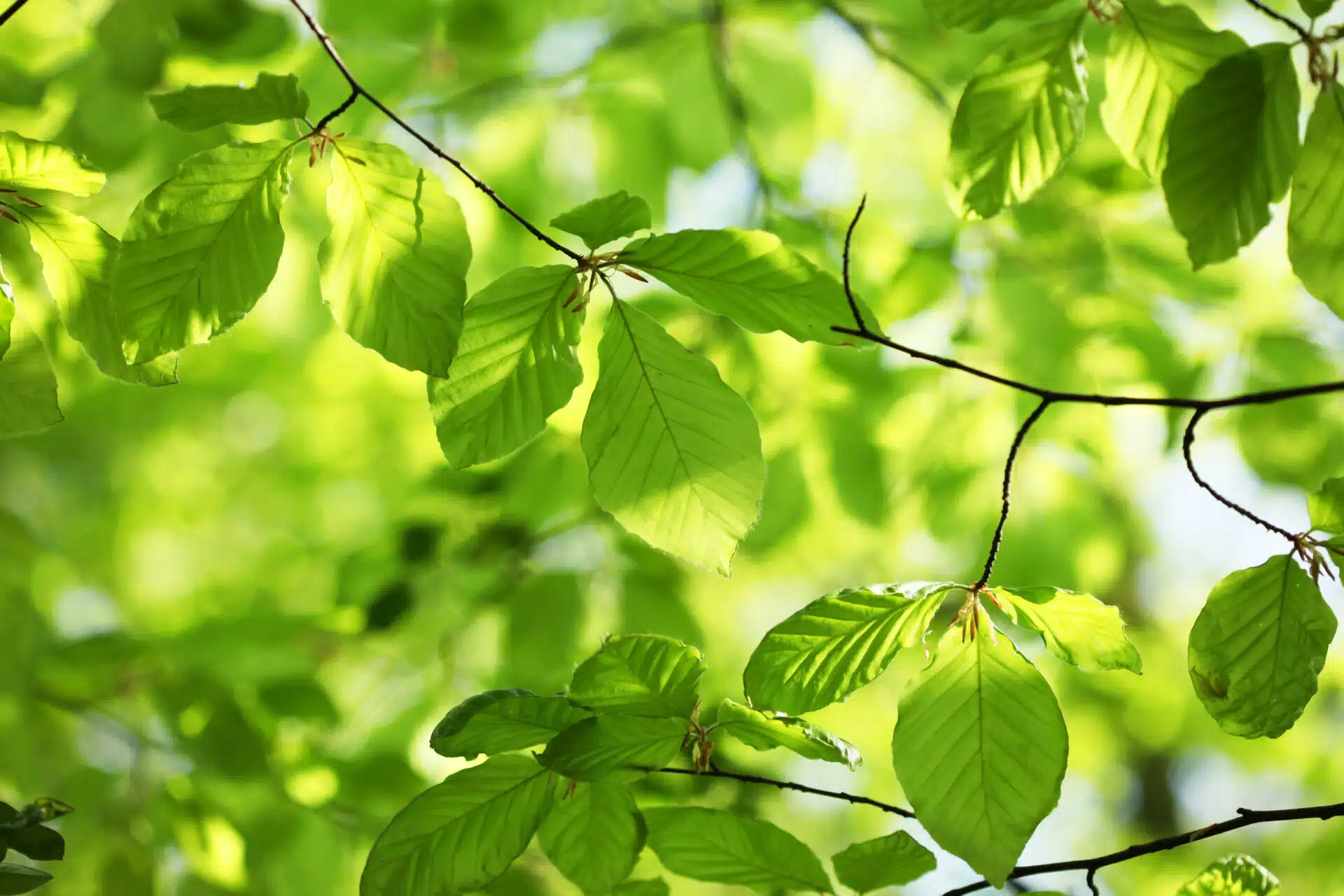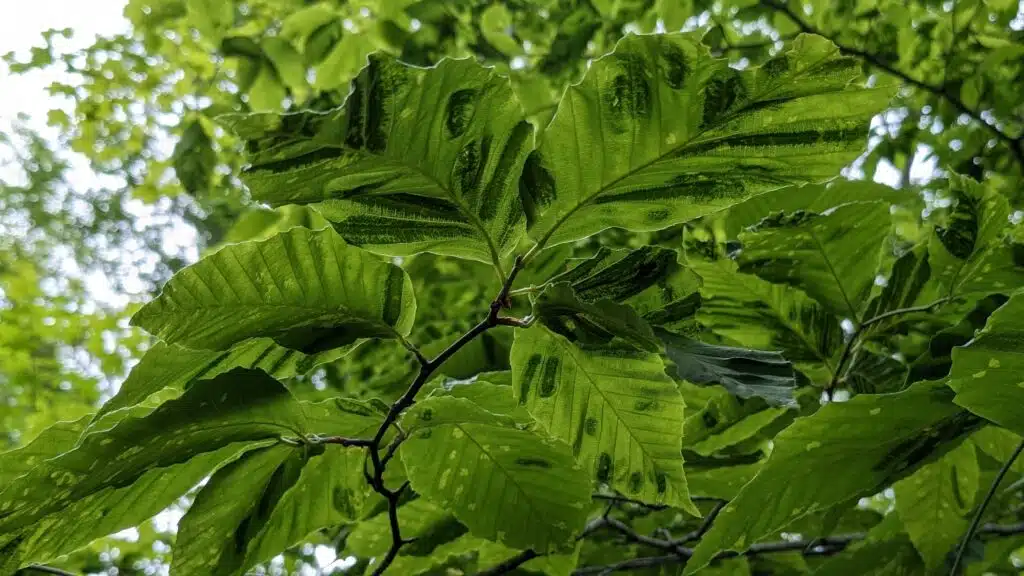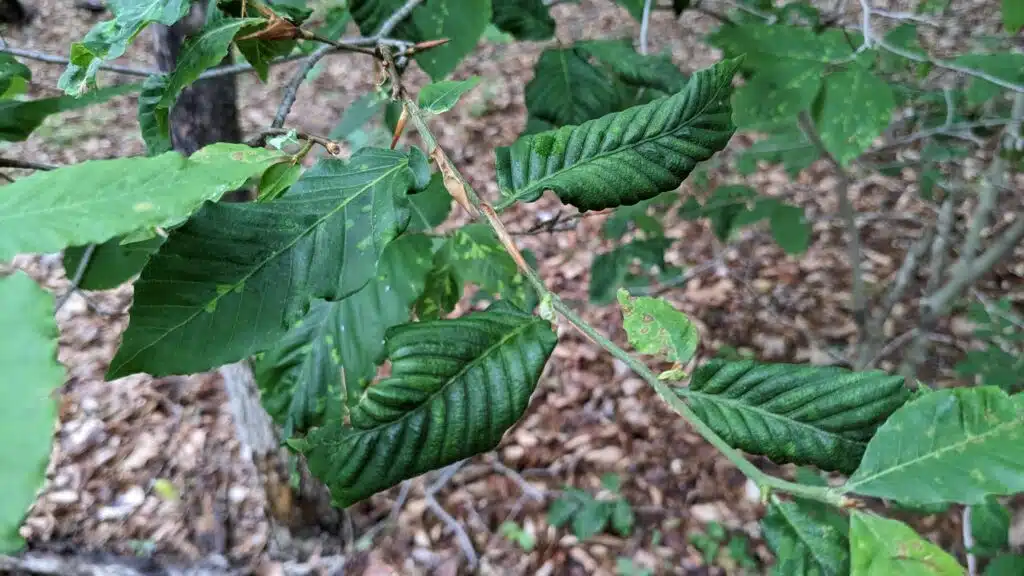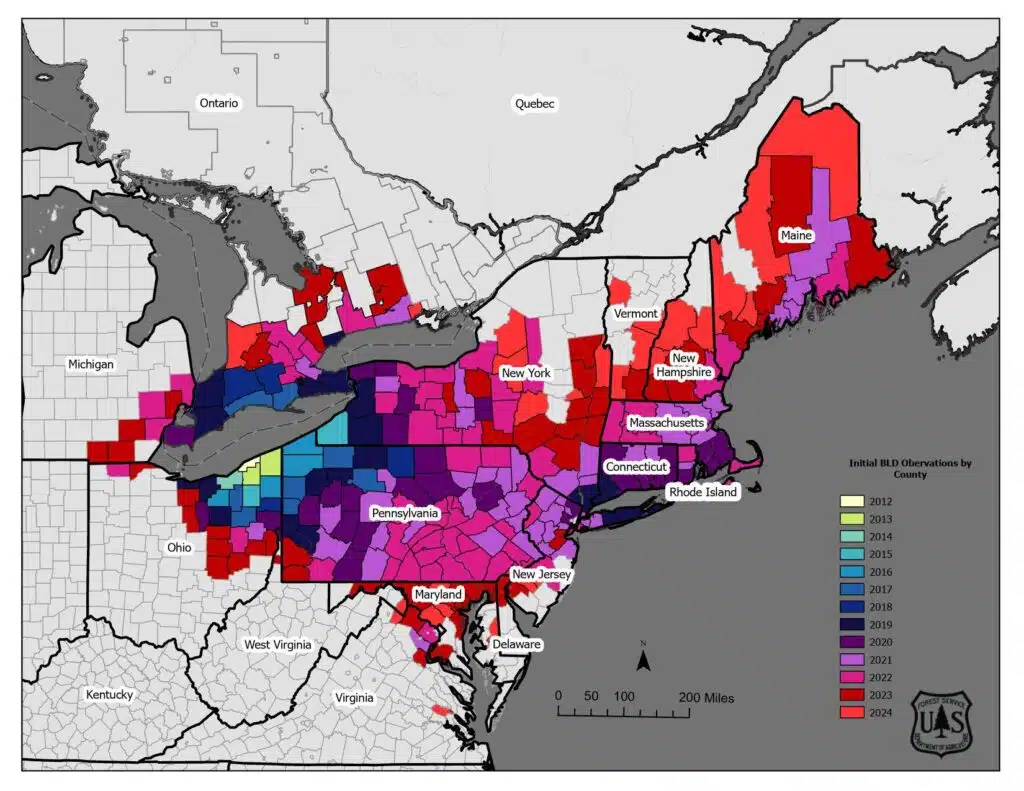Beech Leaf Disease
What causes beech leaf disease, what you can do about it, and the latest research from the experts at Holden Forests & Gardens

Wondering what’s wrong with your beech tree?
Unfortunately, beech leaf disease is prevalent in northeastern Ohio. Affecting our native beech tree, the American beech (Fagus grandifolia), the disease is relatively new on the scene. Researchers at the Holden Arboretum are collaborating with experts across the region to better understand the disease and find effective treatments.
On this page: Forest Outlook | Treatments | Our Research | Beech Leaf Disease FAQ
Wanted: Resistant beech trees!
If you have an American beech on your property that is surviving beech leaf disease while the beech trees around it are dying, let us know! Your tree may be genetically resistant to beech leaf disease, and could play a role in our beech resistance breeding program. Reach out to our Forest Health Coordinator, Rachel Kappler (rkappler@holdenfg.org) with information about your tree. (Please note that if you’re in a developed area, the beech in your backyard may be an ornamental European beech, not an American beech.)
Beech Leaf Disease: Forest Outlook
Beech leaf disease (BLD) was first spotted in northeastern Ohio in 2012. Our researchers at the Holden Arboretum, along with collaborators across the region, have been monitoring and studying the disease from the start. As BLD marches through beech forests across the country, communities in newly-infested areas are wondering: What should we expect? Although the disease will likely affect different areas in different ways, we can still describe what we’ve witnessed in our area over the past decade.
New research from Holden shows 30% of beech trees have died in affected areas, with survivors growing more slowly.
Holden researchers recently reported on beech tree mortality and growth near the disease epicenter in northeastern Ohio: After more than a decade of monitoring, almost a third of beech trees have died, the majority of which are understory trees and saplings, and surviving trees have slowed growth. Published in the journal Trees, Forests and People, this is the first study to quantify the long-term impacts of BLD on American beech.
Learn more: 30% of Beech Trees Killed by Beech Leaf Disease, New Study Shows
Understory trees die within a few years.
In our area, all of our beech-maple and beech-hemlock forests are now infested. Smaller saplings began to die around 4-5 years after we first noticed BLD symptoms, and we estimate that full understory beech death occurred by about 7 years.
Mature canopy trees may or may not survive.
We have not yet seen widespread mortality of mature canopy trees, but some have died, and mortality appears to be increasing. The study found that smaller saplings experienced the highest mortality rates, with up to 14% dying in a single year. While large trees have not yet died at the same rate, many have lost significant portions of their functional canopy, and growth has slowed significantly since the arrival of BLD. The long-term outlook for canopy trees remains uncertain, and we have not seen any trees recover from the disease once infested.
Some individuals may be resistant to the disease.
We are studying what we call ‘lingering’ beech—trees that appear relatively healthy in otherwise infested areas—for possible genetic resistance to BLD. This is a key aim of the Great Lakes Basin Forest Health Collaborative, a regional initiative headquartered at the Holden Arboretum. No tree is fully symptom-free, but some have significantly fewer symptoms—we are studying the trees that have the least amount of symptoms compared to their neighbors, and testing them for resistance. If you find a possible lingering beech, please report it! Submit an observation through the free, easy-to-use app, TreeSnap.
Treatment and mitigation efforts are just beginning.
We have not yet begun efforts to mitigate beech losses in the forests (e.g. planting saplings in affected areas to replace the beech). There are a few treatment options for the disease just recently coming to light (see below), but these have been aimed at individual urban trees—nothing that would rescue a forest. Research is ongoing to better understand the disease itself and how to fight it.
Thanks to Rachel Kappler, Forest Health Coordinator for the GLBFHC, and Connie Hausman, Senior Conservation Science Manager for Cleveland Metroparks, for contributing information for this segment.
Treatment options for beech leaf disease
The number one question we get about beech leaf disease at Holden is, of course, what can I do for my beech trees? Research on beech leaf disease treatments is currently ongoing. Here’s what we know so far, and our recommendations.
Beech leaf disease experts from around the region, including Dr. David Burke, VP for Science and Conservation at Holden Forests & Gardens, announced in March 2024 the long-awaited results of experimental trials of potential treatments for BLD. They found that foliar treatment of the fungicide fluopyram, when applied at the right time, kills over 90% of live nematodes. The study, led by collaborators at Bartlett Tree Research Laboratories, tested treatments including abamectin, acephate, emamectin benzoate, fluopyram, oxamyl, and potassium phosphite on infected trees in Connecticut, New York, and Ohio. The other methods tested were not effective against beech leaf disease (but see note below on potassium phosphite).
Effective fluopyram application needs to occur when the nematodes are migrating out of the leaves and into the buds to overwinter, which occurs in late summer when the leaves are wet, such as after a heavy rain. This treatment won’t improve leaf symptoms in the current year, but would affect the following year’s leaf out. The study was published in the Journal of Environmental Horticulture.

Fluopyram is a broad-spectrum fungicide and should be applied with care. While it has shown strong effectiveness against the nematodes associated with BLD, its impact on non-target organisms — including beneficial fungi in the soil and surrounding ecosystem — is still being studied. For this reason, we currently recommend its use only by professionals and in select, high-value cases. For instance, at the Holden Arboretum, we might consider treating our large European weeping beech, a critical specimen in our Main Display Garden, but would not likely apply fluopyram in any of our natural areas.
Another option that has shown promise in unpublished trials is using potassium polyphosphite fertilizer to reduce nematode number and symptoms of BLD. The mechanism by which this works is not yet known, but the polyphosphite is likely the active agent against the nematodes. Many extension offices have begun to recommend this treatment to their communities. And in a recent multi-site study, root flare injections of thiabendazole (Arbotect 20-S) significantly reduced nematode levels and BLD symptoms in beech trees, offering another promising systemic treatment option where foliar sprays are impractical.
Learn more about how to use polyphosphite fertilizer >
Finally, if you have beech trees, we recommend pruning your trees to increase light and air circulation to reduce moisture in the canopy. Drying out the leaves can limit the nematodes’ life cycle and spread. Trim in winter or early spring when the trees have no leaves, or in late August/September before fall rains return.
Regular tree care such as a fall or spring fertilization treatment, proper mulch application around the base of the tree, and regular watering can also help support your beech trees whether or not they have symptoms of the disease. Adding quality compost — purchased or homemade — around your trees as fertilizer can also help your trees, as it feeds them for a longer period of time, improves your soil quality, and adds needed micronutrients to your soil.
Unfortunately, pesticide application and other treatments showing promise for landscape specimens found in yards and gardens are not practical for treating forested areas. If you manage a forested property showing signs of beech leaf disease, our only recommendations at this time are:
- Don’t proactively cut down beech, unless the trees pose a hazard — some trees may be resistant to the disease and may survive
- Please report healthy trees in heavily impacted areas to forest health professionals (see: Wanted: Resistant beech trees! above).
Beech leaf disease research at Holden
Beech leaf disease was first discovered in 2012 in Lake County, Ohio, not far from the Holden Arboretum. Since the beginning, researchers at Holden Forests & Gardens have been working to understand what causes the disease and how we can fight back. BLD was discovered at Holden in 2014, and quickly swept through the arboretum’s natural areas, where American beech trees are dominant, as well as the beech research orchard at Long Science Center.
Identifying the cause of BLD
The cause of beech leaf disease was not immediately apparent until 2017, when collaborator David McCann from the Ohio Department of Agriculture found nematodes in a sample of infected beech leaves. A team led by Lynn Carta at the USDA-ARS in Beltsville and Holden’s Dr. David Burke used molecular methods called ribosomal DNA marker sequences to identify the nematodes as close relatives of Litylenchus crenatae from Japan. They named this new North American subspecies Litylenchus crenatae mccannii after McCann, and their work was published in Forest Pathology in 2020. A photo of the nematode was on the cover.
To see if the nematode was acting alone in causing the disease, Burke, in collaboration with the U.S. Forest Service, studied bacteria and fungi on leaves and buds from Holden’s beech research orchard. The team found no signs that fungi differed between symptomatic and asymptomatic trees, but bacteria communities were consistently different on diseased leaves. This important early study appeared in Forest Pathology in 2020. Later work would confirm the nematode as the source of the leaf damage, so experts suspect these bacteria are secondary infections.
Another piece of the nematode puzzle came a few months later, in another 2020 Forest Pathology study. Burke, working with a team led by the Ontario Forest Research Institute, found that the number of nematodes increases over the growing season, peaking in fall — and that nematodes are found overwintering in buds. This laid important groundwork for recent work outlining the mechanism by which nematodes cause changes in buds and leaves at the cellular level, causing the BLD symptoms.
In 2025, stunning imagery actually showed the nematodes inside beech buds and leaves. Also this year, the Burke lab reported that the nematode is more widespread than symptoms alone suggest — they found that the nematode can be detected on asymptomatic trees a year or two before symptoms arrive.

Breeding trees resistant to BLD
While researchers in the Burke lab work to understand beech leaf disease, other experts at Holden are working to fast-track solutions. The Great Lakes Basin Forest Health Collaborative is leading the charge to save beech, as well as ash and hemlock, by uniting efforts across the region to breed pest-resistant trees. Led by Forest Health Coordinator Rachel Kappler, their base is at the Holden Arboretum.
It’s become clear that some beech trees, even in highly affected areas, develop little or no symptoms. This means they have some level of genetic resistance to beech leaf disease. The GLB FHC is coordinating efforts to locate these trees, test them for resistance, and breed them for eventual replanting efforts. If you have a potentially resistant tree, tell us! Reach out to Rachel Kapper (rkappler@holdenfg.org) with information about your tree.
When we identify a potentially resistant tree, with the landowner’s permission, we may take a cutting and bring it back to the greenhouse at the Holden Arboretum. There, we graft the branch onto a healthy rootstock growing in a pot, which allows us to run tests on it. We’ll test these grafted trees — genetic clones of the trees out in nature — with nematodes to see if they really are resistant. If they are, we’ll incorporate them into our long-term breeding program in hopes of using them for future forest restoration all across the affected region.
BLD research continues
While the GLB FHC works toward BLD-resistant beech trees, research into the causes, consequences, and potential treatments for beech leaf disease continues at Holden. In April 2023, Holden researchers found a new downstream effect of the disease: The roots of infected trees have fewer helpful fungal mutualists called ectomycorrhizal fungi. That’s bad news for both the trees and for the fungi species they support. Their work is published in the Journal of Fungi.
Also in 2023, researchers in the David Burke lab developed an improved, effective way to monitor and detect the presence of the disease-causing nematode in beech leaf tissue. The new tool uses a long-standing laboratory method that can be used to detect DNA specific to a certain organism. Previously, forest health professionals looking for the nematodes would have to undertake a slow process that involved soaking leaves for twelve hours, further preparing samples, and then looking for nematodes under a microscope — not something that could be done at large scales. The new method is detailed in the journal Plant Disease.
More recently, the team expanded on this method, demonstrating an effective way to collect samples off trees. They found you can detect BLD-causing nematodes in water collected while flowing down tree trunks during rainstorms.
Published in May 2024 in the journal Applied and Environmental Microbiology, the Burke lab group presents results from recent surveys of bacteria, fungi, and nematodes they conducted on beech trees across nine sites across Ohio and Pennsylvania with different levels of disease symptoms. Their goal was to understand how nematode infestation and BLD symptoms impact the communities of bacteria and fungi that live on the leaves of beech trees.
Beech Leaf Disease FAQs
What does beech leaf disease look like?
The main symptoms of beech leaf disease are green stripes, called interveinal banding, on the leaves and sometimes thick, leathery, or even stunted-looking leaves. Note that yellow or red spots on beech leaves are signs of other diseases, not BLD.
How can I tell American and European beech apart?
American beech is the only beech species native to North America, but if a beech tree is planted in your landscaping, it may be a European beech or other species. The easiest way to tell these two trees apart is to look at the edges (margins) of the leaves: American beech leaves are serrated (toothed), while European beech leaves are smooth.
There are a number of other differences; this webpage from bplant.org has a nice side-by-side comparison of the two species with photos.
Can I proactively protect my trees from beech leaf disease?
There is no way to prevent beech leaf disease from spreading to your trees. We recommend strategic pruning to reduce moisture in the tree canopy, especially before fall when the nematodes spread (see “treatment options for beech leaf disease,” above).
Should I cut down my beech trees?
No, and especially not proactively (that is, before you see symptoms of beech leaf disease). Your beech trees may be resistant to the disease and may survive. Resistant trees are also valuable, as we can use them for breeding selection programs with the U.S. Forest Service. Of course, if your tree has seen serious decline and is posing a hazard, then it should be removed. An arborist can help with that decision.
How far has beech leaf disease spread?
Beech leaf disease is an emerging threat to North American forest ecosystems. Symptoms of the disease were first discovered in northeastern Ohio in 2012, and it has already spread to Michigan, Ontario, and as far eastward as Maine and Virginia.
Recent research also suggests that the disease is more prevalent than symptoms alone suggest—nematodes have been detected on asymptomatic trees one or two years before symptoms became visible in the area.
Read more: Beech Leaf Disease-Causing Nematode More Widespread Than Visible Symptoms Suggest, New Study Finds

What causes beech leaf disease?
Beech leaf disease is caused by an invasive nematode, Litylenchus crenatae mccannii, which was first discovered in 2017. Nematodes are microscopic, wormlike animals that are small enough to live inside leaves and buds of trees. The nematodes enter the tree’s buds and feed on tissues inside over the winter, which causes the damage to the leaves.
What trees can be affected by beech leaf disease?
Our native American beech (Fagus grandifolia), European beech (F. sylvatica), and other common ornamentals like Oriental Beech (F. orientalis), and Chinese beech (F. engleriana) are all affected by beech leaf disease. At this time it seems Japanese beech (F. crenata) may be resistant. Researchers have detected signs of the nematodes on other trees, like maple trees, but those trees haven’t shown any sign of disease.
Read more: New Study Confirms Beech Leaf Disease Threatens European Beech Trees, Too
What beech trees are safe to plant?
For now, we don’t recommend planting any new beech trees.
Are the beech trees getting any better?
We’ve noticed variation in the severity of symptoms on some trees from year to year, which in a good year can appear as if the trees are getting better. We’re not yet sure what causes this variation, but suspect it has to do with weather conditions in the fall, when the nematodes are moving from leaves to buds. We would expect a drier fall to be harder on the nematodes, resulting in fewer beech leaf disease symptoms the following season. When this happens, the trees aren’t so much “better” as getting a break from the nematodes’ damage for the season.
Where can I find polyphosphite fertilizer for beech trees? How do I use it?
Researchers have found that applying PolyPhosphite 30®, 0-0-27 helps reduce nematode numbers and alleviate the symptoms of beech leaf disease. Before applying, we recommend contacting your county’s extension office for a soil test to make sure you don’t overdose the trees — as with any fertilizer, too much hurts the trees.
PolyPhosphite 30 is a specific brand that’s only available for professional/commercial use, but alternatives are available for homeowners. It’s a potassium polyphosphite fertilizer. To search for alternatives, look for products called “potassium polyphosphite” (note the “i” in phosphite; phosphate with an “a” is a common fertilizer and may autocorrect). We suspect the polyphosphite is the active agent against nematodes, but have no information on whether other phosphite fertilizers, like calcium phosphite, have the same effect as potassium polyphosphite.
The exact concentration of the product shouldn’t matter (the label will say “0-0-X”); you will need to follow the directions to prepare the solution for use (e.g. for a 27% solution like PolyPhosphite 30, you would use at least 1 gallon of water for every 2.5 oz of fertilizer concentrate, per the label).
Note also that products you find may be labeled as “foliar” liquid fertilizer but its effectiveness against BLD is as a soil drench. Do not spray on leaves. After diluting your solution according to the label, apply 1 quart per inch of stem diameter (measured at 4.5 feet, or DBH), drenching the soil around the base of your tree. Read all labels carefully before use and follow all recommended safety protocols. Rubber gloves or latex gloves are recommended while handling this or any chemical. Do not apply too much or too often (once a year should be enough). Again, a soil test from your extension office will help assess the need to reapply.
Can I help document healthy or diseased beech trees?
Yes! The best way to submit an observation of an American beech tree is through the free app TreeSnap. Take photos of the leaves, bark, and other identifying features so experts can confirm your beech identification, and make sure symptoms are visible if you’re submitting a sick tree. It’s especially important to report healthy trees in otherwise-affected areas. These healthy beech trees might be resistant to BLD and could be used to breed resistant trees for replanting. You’ll submit photos and other information about your observation right in the app. To report a healthy American beech, you can also reach out to our Forest Health Coordinator, Rachel Kappler, directly (rkappler@holdenfg.org).
How is beech leaf disease different from beech bark disease?
Unfortunately, there are not just one but two major pests — beech bark disease and beech leaf disease — bothering our region’s beeches. Beech bark disease is caused by a fungus-insect duo that can girdle a tree and result in its death. First the scalelike insect Cryptococcus fagisuga pierces the bark to feed. Then, that damage allows the canker fungus, Nectria spp., to move in and kill the tree. Many mature beech in the northeastern U.S. have already been lost to beech bark disease.
Need help with a beech tree on your property?
If you have a beech tree on your property and would like advice from an expert, we recommend reaching out to a local tree care company. However, do remember that this is an emerging disease — even the world’s experts are still trying to figure out the biology of how it works, which means recommendations for how to treat it may update quickly.
Contact us
Last updated: July 18, 2025. Have new information to share or see something that needs an update? Contact Anna Funk, below.
To report a resistant beech tree, please contact:
Rachel Kappler
Forest Health Coordinator
rkappler@holdenfg.org
General inquiries please contact:
Anna Funk
Science Communications Specialist
afunk@holdenfg.org




